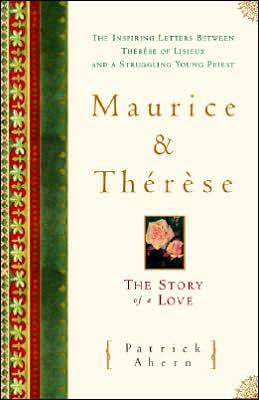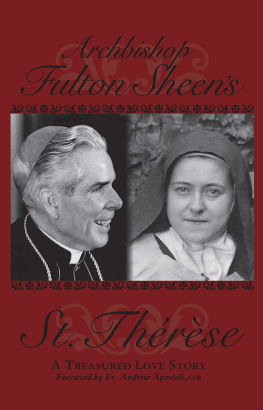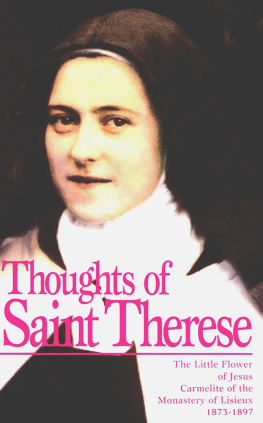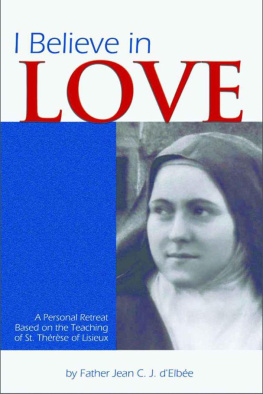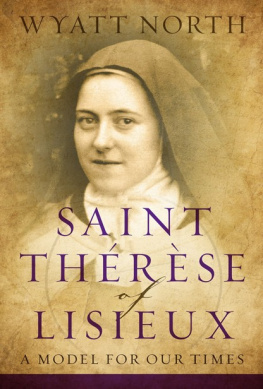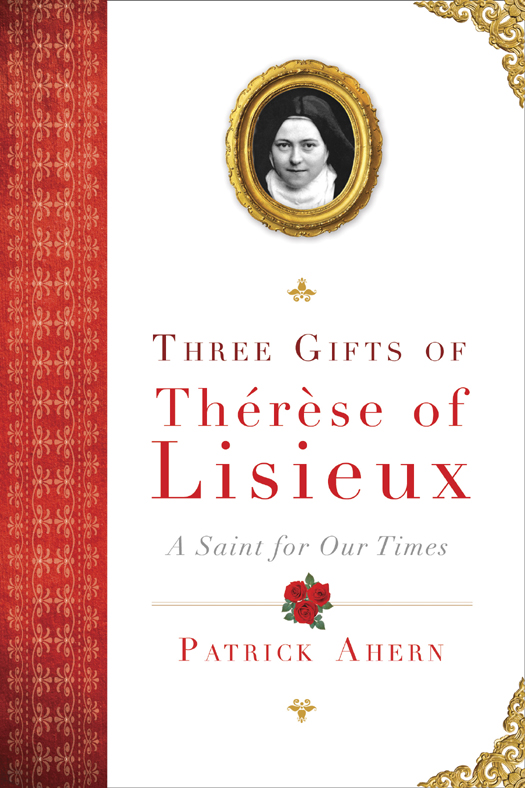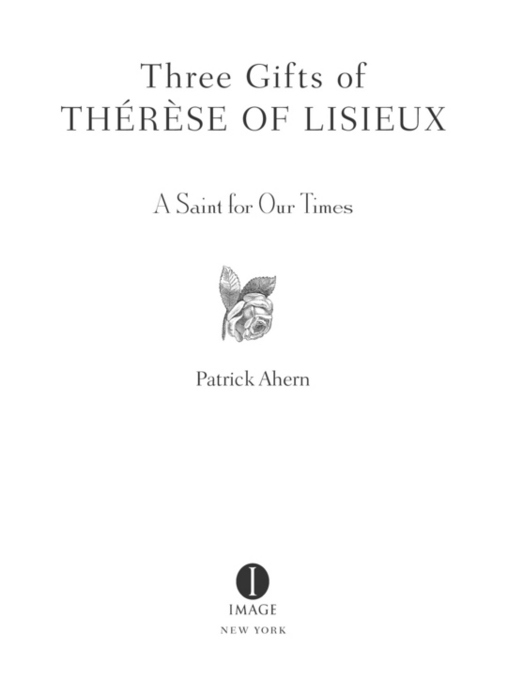Copyright 2014 by Patrick Ahern
All rights reserved.
Published in the United States by Image, an imprint of the Crown Publishing Group, a division of Random House LLC, a Penguin Random House Company, New York.
www.crownpublishing.com
IMAGE is a registered trademark, and the I colophon is a trademark of Random House LLC
Library of Congress Cataloging-in-Publication Data
Ahern, Patrick V.
Three gifts of Thrse of Lisieux: a saint for our times/Patrick Ahern.First Edition.
p. cm.
1. Thrse, de Lisieux, Saint, 18731897. I. Title.
BX4700.T5A73 2014
282.092dc23 2013008544
ISBN 978-0-385-34789-1
eBook ISBN 978-0-385-34790-7
Jacket design: Nupoor Gordon
Cover photographs: Shutterstock
v3.1
CONTENTS
INTRODUCTION
At first glance, Patrick Ahern and Thrse of Lisieux might strike most people as an odd couple. Ahern was born and raised in New York City. He rose quickly through the ranks of the priesthood to become secretary to Francis Cardinal Spellman of the Archdiocese of New York during the tumultuous 1960s. It was a position that put him front and center on such issues as the Vietnam War and the civil rights movement, as well as taking him around the world to assist Spellman who was the apostolic vicar for the U.S. Armed Forces. Company for dinner often included the likes of General William Westmoreland and Chiang Kai-shek, the latter serving then as president of China but from the island of Taiwan.
Ahern was by nature witty and gregarious. Often the life of the party, he entertained guests by singing Irish tunes or opera lyrics. At Spellmans request, he once sang for Bob Hope while they were waiting in an airport for their flight. Hope quipped that Ahern was the only morning lounge singer he had ever heard. Ahern was also known for striking up conversations with strangers on the street, something he thoroughly enjoyed as much as his encounters with political leaders and great artists.
But more important, he took to heart the people under his carethe families in his parish as well as the hungry, homeless, and abandoned. As pastorand in 1970 as bishophe embraced his responsibilities locally and within the American church enthusiastically. It was he who led the local Catholic churches and community leaders to launch the Northwest Bronx Community and Clergy Coalition in the mid-1970s. The coalition became the voice for community revitalization, leading to the creation or renovation of tens of thousands of units of affordable housing to replace the apartment buildings that had been lost through abandonment, vandalism, and arson.
In a later post on Staten Island, he listened to parents who told him of their frustrations caring for their children with special needs, including Down syndrome and autism. They felt the Church offered little assistance, and, wanting to help, he founded the Seton Foundation for Learning. The result was the institution of a group of schools that today educates developmentally disabled children from Staten Island, Manhattan, and Brooklyn from nursery school through high school and beyond.
Thrse, on the other hand, was so shy and reticent that she was pulled from boarding school and tutored at home as a child. Except for one pilgrimage to Rome with her sister and father, she lived most of her brief life in the small French town of Lisieux, and died at age twenty-four in a cloistered convent she had joined nine years earlier. In the convent her life was uneventful. The other sisters could not think of anything significant she had done and didnt know what to write in her obituary. It was only after her death that her spiritual autobiographywhich she wrote at the request of her superiorsbecame known. It was well received in other Carmelite convents and shared with family and friends. Word of her work spread rapidly, and two thousand copies of the published book, The Story of a Soul, sold out quickly. Her autobiography led to her worldwide popularity.
What drew this well-established priest to this saint from the time he was in the seminary? When asked to preach, more often than not he included a story about herwhether he was speaking before a group of adolescents he was about to confirm, addressing priests and nuns on retreat, or saying Mass at the local parish where he lived. He learned French in his seventies so he could bypass translations and read Thrses original writings and the new books written about her by French scholars. He was one of the leading proponents of her being named a Doctor of the Church and personally presented this cause to Pope John Paul II.
Ahern was on the altar with Pope John Paul II in Rome in 1997 when the pope conferred this title on Saint Thrse almost to the day of the hundredth anniversary of her death. She was only the third woman to hold this title. Recently, a fourth woman, Saint Hildegard of Bingen, was declared a Doctor of the Church. In his retirement Ahern continued to pursue his interest in Thrse, and in 1998 his book Maurice and Thrse: The Story of a Love was published. It is about Thrses friendship with a young unknown priest, Maurice Bellire. Writing it, Ahern said, only solidified his love for her and led to more talks and sermons about her, and eventually to this book, which tells his own story as a priest at the same time as it tells the story of Thrse.
To Ahern, Thrse was part of the modern world, no stranger to its stresses or to the wonder and possibilities that it held. He often referred to her as a saint for our times, and this universal appeal was first of the three gifts she gave us. She was ordinary; she was one of us. We know about her pet dog, her family life, her relationship with her sisters and uncle and cousins, her desires and dreams. We know what annoyed her, what tempted her, and we know about the doubts that shook the faith that had sustained her for as long as she could remember. Thrse was accessible, and Ahern never grew tired of rereading her autobiography. He found strength and guidance in her words.
In the first section of this book, Ahern describes the losses Thrse endured as a child and the psychological toll these traumas took on her. Ahern believed the sequence of events in her early childhood is pivotal to understanding both her behavior as a child and also her relevance today. Putting the pieces together with the understanding afforded him by contemporary psychology, he goes beyond linking her extreme sensitivity to her mothers death when she was four. He clarifies what he believes was the true source of the struggles that she strove to overcome and finally did when she was thirteen years old.
Ahern was clearly attuned to the psychological impact of childhood events. His father was an alcoholic, although he provided for his family and saw to it that his sons were raised well. Ahern, ever respectful and loyal, took over his care after his mother died in 1948, visiting him daily in a Carmelite nursing home during the last few years of his life. But it was a relationship that caused him a great deal of pain and resentment. If Thrse grew up in a home with tremendous loss but always love, Ahern was left with memories that were the source of tremendous insecurities. How could you be so stupid? was the question he recalled his father badgering him with. His mother tried to offset episodes that she knew left their mark on her two sons. When she saw Patrick in the morning looking downcast, she would try to cheer him up by saying, I see Larry on your back. I am going to get him. Larry was her term to describe whatever was troubling him. Often she could raise the spirits of her youngest child and make up for her husbands lapsesbut not always. His spirit and his confidence were often undermined, he would later admit.


